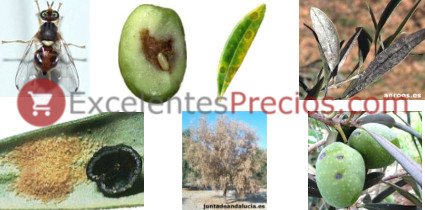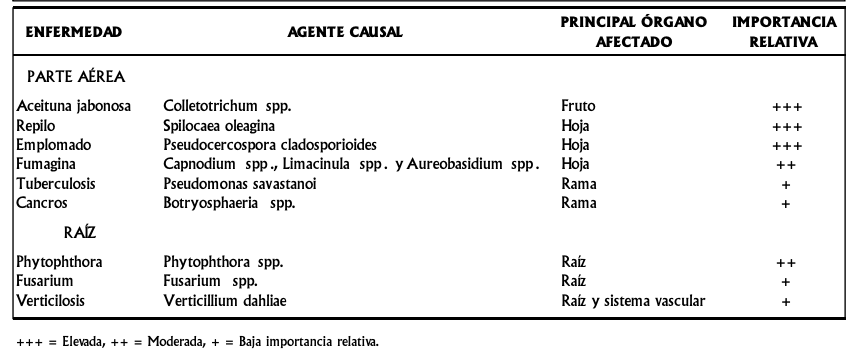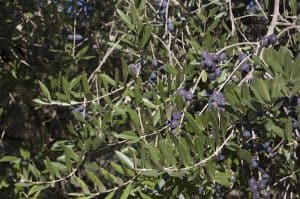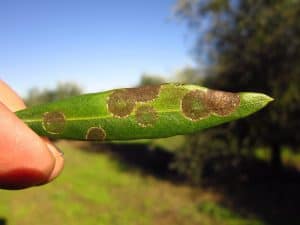What Diseases and Pests Attack the Olive Tree? [Treatments]

Olive cultivation has traditionally been developed in regions with a Mediterranean climate, with bright and relatively dry summers, where the incidence of diseases caused by fungi and bacteria is relatively low.
On the contrary, agroecological conditions with moderate winters and high rainfall and relative humidity, favor the development of diseases caused mainly by fungi that negatively affect the productivity of the olive grove and the quality of the final product.
For example:Some pathogens that affect the fruits cause an increase in the acidity of the olive oil and prevent the production of extra virgin oil, thereby losing quality and economic value.
We all like to consume the products that come from the olive tree, such as olive oil that cannot be missing at home.
The problem is that there are many common olive tree diseases that can put good harvests on the line.
And given the high level of production that Spain has in this matter, it is something that may concern many people and farmers.
The fact is that like all diseases, there are treatments designed to ensure that plantations remain healthy at all times.

soapy olive
 It is one of the diseases that most causes discomfort in olive growers because it directly attacks the fruit.
It is one of the diseases that most causes discomfort in olive growers because it directly attacks the fruit.
Its presence causes it to turn brown at one or more points until it becomes larger and ends with the fruit.
In some cases, the disease can take part of the leaves and even the trunk.
This expansion is carried out continuously until the entire plant is finished.
Its presence is much stronger in the rainy periods, so that when autumn arrives, the crops must be maintained with greater vigilance.
Soapy olive or anthracnose is one of the main diseases of the olive tree in all the regions where it is grown.
It causes rotting, weight loss and premature fruit drop.
The oil made from affected fruits may show alterations in color, taking on reddish colors, and it also has high acidity and poor organoleptic quality. The incidence of the disease varies according to varietal susceptibility, climatic conditions and the virulence of the pathogen.
Soapy olive treatment
There are products on the market that are specifically designed for the prevention and control of this disease.
However, its correct operation will also depend on taking the necessary care with the plant.
This means making your fertilizer and irrigation properly, both in quantity and time.
- To know more: How to pay an olive tree
Repilos
 This is one of the most characteristic diseases of the olive tree and its presence is usually manifested in different ways depending on the area of the plant.
This is one of the most characteristic diseases of the olive tree and its presence is usually manifested in different ways depending on the area of the plant.
The first are usually spots on the upper part of the leaves that are outlined between green and yellow and then turn black.
All this brings with it a forced weakening of the leaves that is transferred to the branches and, finally, to the olives.
As it is a disease capable of destroying the entire plantation, growers take great care to ensure that it does not occur.
Treatment of the repilos in the olive tree
One of the most common ways to attack the disease is by removing the areas that are affected.
However, there are times when this simple action is not enough.
For this, the care begins from the time of autumn applying copper -based treatments.
Later, during the spring, we will work with the fungicides that apply for this case.
Of course, ensuring that the plant is well fortified helps prevent this issue from becoming serious.
verticillium wilt
Although it is not one of the most frequent diseases, it is counted as one of radical action.
The reason is that it is produced from the land where the plant is planted, so its eradication is a complex matter.
Depending on the way it is presented, there are two variations:
- Apoplexy: This is a quick and devastating condition that kills the plant in a very short time.
- Slow- acting: a much slower process is generated, causing the fruits to dry and, subsequently, the rest of the plant.
Treatment for verticillium wilt in the olive tree
The outlook for this disease is not positive, but it does not mean that there is nothing that can be done.
In some very serious cases, it is best to remove the plantation and place a resistant rootstock.
Other growers apply the burning of the affected parts and allow to assess how time passes with the remaining ones.
It is also useful to carry out a correct disinfection of all the material used to work with the plants.
olive scab
When the plague has suffered wounds and it has become infected, what is known as olive scab occurs.
In some scenarios, it is also known as tuberculosis of the olive tree and its main symptom is the presence of bumps.
These bumps or tumors prevent the sap from circulating properly, preventing the proper development of the plant.
As the branches dry out, the plant is unable to develop properly.
Olive scab treatment
When this disease attacks, it is caused by a bacterium and not by a fungus, so its eradication is almost impossible.
Hence, a correct visualization of the development of the plant is key throughout the process.
A good technique is to prune the affected areas to prevent its spread.
Of the rest, it will only be necessary to apply a preventive treatment that will consist of using fungicidal products as the case may be.
There are versions on the market that are capable of dealing with both olive scab and repilos.
It is important to note that these plants can manifest diseases on autumn and spring days, especially.
Hence, proper supervision throughout the year is essential.
Bibliography and references
-
[PDF] Diseases of the olive tree, P Conde, MJ Montelongo, C Leoni – Olive oil: from the plant…, 2013 – researchgate.net
-
[BOOK] The cultivation of the olive tree 6th ed. D Barranco Navero, R Fernández Escobar… – 2007 – books.google.com
-
[PDF] The repilo of the olive tree, A Trapero Casas – 1994 – helvia.uco.es
-
[PDF] Cupric fungicides in the control of olive tree diseases, LF Roca, JR Viruega, A Ávila, R Oliveira, F Marchal… – Vida Rural, 2007 – expoliva.com
-
Manual of recognition of diseases and pests in olive trees, EJA Oriolani, L Otero, AC Matías, AM Nieto… – … Aires. INTA editions, 2008 – sidalc.net
-
[PDF] Anthracnose of the olive tree and its effect on the quality of the oil. J Moral, C Xaviér, LF Roca, J Romero, W Moreda… – Fats and…, 2014 – core.ac.uk



![Photo of Caring for Indoor Flowering Plants: [Humidity, Pruning and Problems]](https://www.complete-gardening.com/wp-content/uploads/2022/08/caring-for-indoor-flowering-plants-humidity-pruning-and-problems-390x220.png)
![Photo of Corn Piral (Ostrinia nubilalis): [Characteristics, Detection, Effects and Treatment]](https://www.complete-gardening.com/wp-content/uploads/2021/06/Que-es-el-piral-del-maiz-scaled-1-390x220.jpg)